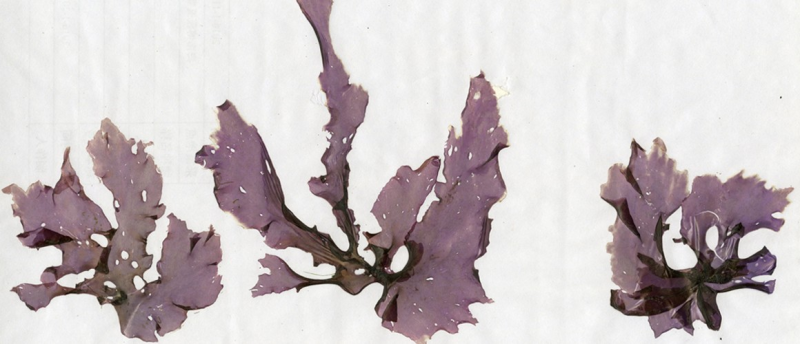Calidia pseudolobata. Credit: Dr. Li-En Yang
Researchers, including those at the Natural History Museum in London, have discovered a new species of seaweed Calidia pseudolobata as well as four new genera of red algae from the warm waters of China. The research suggests there are many new species yet to be discovered—with potential implications for marine biodiversity and food security.
The world faces multiple challenges from population growth to threats to agricultural production. Due to a lack of land, the impact of environmental and anthropogenic change on coastlines, and shallow seas around the world, there is an increasing need for seaweed species and strains which could be brought into aquaculture—the farming of fish, crustaceans, molluscs, aquatic plants, algae, and other organisms.
The red algal genus Pyropia sensu lato includes several species of economic importance to China, Japan and Korea where they are farmed for nori, an aquaculture crop that when processed is the black wrapping used in sushi.
The research features in a new paper published in the Journal of Phycology. Co-author and Merit Researcher at the Natural History Museum Prof. Juliet Brodie said: "Pyropia is a cosmopolitan, large group of organisms but extremely hard or impossible to identify in the field based on what they look like [morphological features]. This raises questions as to where and how to go about the search for potential crop candidates. It's exciting to find a new species from our research, we should never underestimate the value of biodiversity discovery and understanding species relationships. Such fundamental knowledge is the basis of our existence, survival and well-being."
Researchers in this study revised the taxonomy of the genus Pyropia using a combined molecular and morphological approach, providing definitive evidence that Pyropia is made up of several genera whose distribution is indicative of their underlying evolutionary history. By using these techniques,
researchers revised the concept of Pyropia (subpolar to cold temperate), described four new genera, Calidia (tropical/subtropical), Neoporphyra (warm temperate), Neopyropia (cold temperate) and Uedaea, and resurrected an old genus, Porphyrella. The study described 33 new name combinations.
Professor Brodie continues: "The results of this study have big implications for the nori industry. Traditionally, the economically important species Pyropia tenera, P. yezoensis and P. haitanensis used in aquaculture in Asia went under the genus Porphyra until this genus was split a few years ago and they were transferred to Pyropia. As a result of our work, Pyropia tenera and P. yezoensis move to the genus Neopyropia, and Pyropia haitanensis is moved to Neoporphyra."
The new research demonstrates the importance of fundamental biodiversity discovery underpinned by a robust taxonomy in order to apply such knowledge. Redefining Pyropia, coupled with an understanding of the distribution of the new genera, provides a potentially powerful tool for the discovery of new seaweed species/strains for aquaculture.
More information: Li‐En Yang et al. Redefining Pyropia (Bangiales, Rhodophyta): Four New Genera, Resurrection of Porphyrella and Description of Calidia pseudolobata sp. nov. From China 1, Journal of Phycology (2020). DOI: 10.1111/jpy.12992
Journal information: Journal of Phycology
Provided by Natural History Museum
























